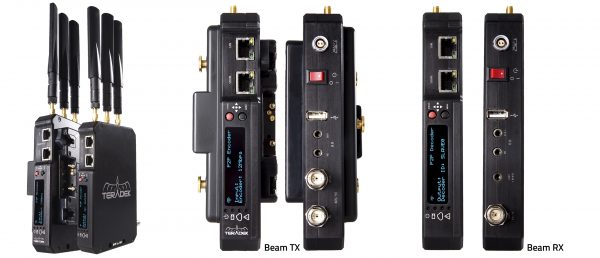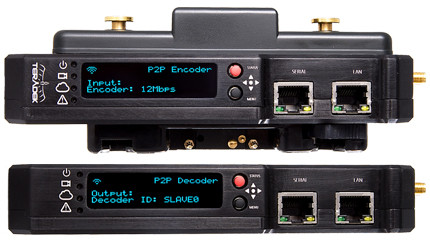
Andy Smith is a BBC-trained lighting cameraman from the UK who’s had a varied shooting career over the past 25 years. Here he takes a look at the Teradek Beam, an alternative to expensive radio kits for those needing an on-camera remote transmission system.
Comparing systems
Traditional SD and HD radio systems cost around £20k to £30k from the likes of Gigawave, Link or Cobham. The Teradek Beam comes in at under £4k so I was a little dubious about its comparable performance both in SD and HD at that price point.
High-end digital radio camera systems are based on a transmission standard called COFDM (Coded Orthogonal Frequency Division Multiplex) – an RF modulation scheme. The big advantage with COFDM modulation is that reflections and multipath signals you find in stadia and other buildings add to the robustness of the link rather than degrading it.
The Teradek Beam uses an IP transmission system, meaning that once it has encoded your video to an h.264 IP stream, it is transmitted via 5Ghz Wifi to the receiver. There are two ranges of spectrum available for Wifi: 2.4Ghz and 5Ghz, and the latter band is less likely to experience interference as it’s less commonly used by domestic devices.
The link will also regularly hop frequencies, so although you are on the same channel as someone else, you may not be on the same frequency at the same time. A major advantage to using Wi-Fi transmission is it is licence exempt which is not the case with COFDM systems.
First impressions
The Beam came packaged in a foamed-out Peli-type case. Transmitter and receiver are both housed in high grade metal and feel very rugged.
Neither unit is waterproof so would need some weather protection, especially if mounted up high to get best line-of-sight in foul weather.
Power
The transmitter was powered from the camera battery and didn’t cause any excessive drain. The receiver is supplied with a mains power supply and short cable. There’s a standard Lemo DC input connector on both units rated at 7 to 17 volts DC so auxiliary power input is possible.
Range
The manufacturer claims an 800m-range line-of-sight at 12Mbps. To test it out and give it the best possible chance I took the system to my local lake. The receiver was attached to my car on one side of the water with the antenna at about 50cm above head height. I left an observer in the car with a monitor and walkie-talkie, and I set off. I went at least 250m before I ran out of lake and the Beam was still working, but only in direct line-of-sight. Once I was more than about 50m away, if I went behind an obstacle (like a building or dense vegetation), it would fail immediately. However it would recover very quickly once the link re-established. It usually took less than five seconds to provide good pictures again, and there was no need to reboot the receiver as has been reported with other systems of this type.
The other advantage is that it failed in a very elegant manner – slight pixellation, then a full frame freeze. No flashing, no banging, blocking or break-up. It was also very clean on the re-establish – freeze frame to sudden full motion again.
If I was closer to the vehicle (30m to 50m) then I could go behind obstacles like hedges and buildings and still maintain contact. Likewise, I could walk up a road for about 30m and then get about 20m around a corner before experiencing any trouble. In a fully populated street with lamp posts and other street furniture, parked cars and various trees and vegetation, I was able to get 70m away from the receiver before it would start to get marginal.
It also worked well from inside a domestic building, even from a room at the rear through windows and internal walls to the vehicle parked on the front driveway outside, all without direct line of sight. It was faultless at a range of about 20m.

Latency
If you’re going to use this system for live broadcast, you will have to consider system latency and how anything in the signal chain may affect the delay in your presenter answering a question thrown from the studio. I used a ‘Smart lips’ lip-sync monitor to check the manufacturer’s claims of two frames (80 milliseconds) of latency and ended up with a result of 100ms (2.5 frames) which I consider to be very useable.
IFB / Clean feed circuit
The Beam also has a facility of a reverse audio bearer via its intercom circuit, so you can introduce the studio audio (IFB or clean feed) off the satellite path, an IP or GSM telephone into the receiver and this will appear on a socket on the transmitter. You can feed this into a presenter’s earpiece so they can hear the studio without cables. Very neat, but this also introduces extra five frames of latency into the signal chain. If you use the IFB circuit, you must consider the system latency to be 300 milliseconds or 7.5 frames.
Picture quality
The pictures were great. Under field viewing conditions they looked identical to pictures directly out of the camera. There is some compression on the link which will affect picture quality but this is selectable. You can go down as far as 5Mbps and up to 30Mbps via radio (there’s also an option to run a cable between the units at up to 50Mbps). For all my tests I used a 12Mbps HD link as I guessed there would be an impact on range and reliability if you went much higher, and satellite links usually have much less bandwidth than 12Mbps, especially for news.
Niggles
The only trouble I could find with the transmitter is that when mounted on the camera in front of the battery the HDSDI-output BNC of my PMW500 was inaccessible with a full-sized cable as the transmitter fouled the access. You couldn’t use a right-angled adapter to help either as that fouled it too. I had to make up a smaller cable (RG213) and bend the BNC plug a little to make it clear.
The Beam’s transmitter antennae are also very close to the radio mic receive antennas on a PMW500 and this did cause the radio mic receiver to break squelch if the radio mic TX was not powered. I was concerned that this would desensitise the radio mic receiver, so did some radio mic range tests with the Beam transmitter powered. The radio mic range was unaffected.
Boot up time for the TX and RX is 45 seconds. Fine when you first rig and establish, but 45 seconds is a long time if you suddenly need to change the camera battery at two minutes to air. That’s going to cause some panic at the broadcast centre, so you will have to adjust your working practices to ensure this does not cause a problem.
Operational testing
So much for trials without production pressure, now a real world test. While I had the loan unit, I had a call from Links Broadcast to provide a live camera into their Ku band uplink truck UKI 787. Links had hired in a Link XP COFDM SD radio system for the task but I offered to try the Beam to see if anyone would notice the difference. It was an SD job for Al Jazeera, uplinked to their Eutelsat 16 satellite capacity then direct to their MCR and studio complex in Doha, Qatar in the Middle East. We worked the link at 12Mbps, although we could have gone to a lower data rate for SD.
The RF path was about 40m to the uplink across the road. The receiver was rigged above head height on the truck and SDSDI feed from the RX into the vehicle matrix. The transmitter was on the back of the camera between the camera body and the camera battery, making very little difference to the overall camera balance when handheld. Embedded SDSDI was connected from the camera to the TX. IFB was via GSM in the uplink and sent to the presenter via a radio earpiece.
We did the first three or four inserts into Doha. Mark, the SNG engineer, paid close attention to our output and confirmed there wasn’t any break-up caused by passing HGV’s etc. By the end of the day, we had clean pictures throughout, and still nothing was said in Doha, so I concluded that we had provided normal service. That was a major success.
Conclusion
I’ve had the loan unit for a month and haven’t found any major problems. It performs perfectly well as a short-range radio camera system. It’s rugged and robust. The pictures are great with very little latency.
Personally I don’t think I would ever use the RS432 data, the streaming server, or the IFB/intercom, but others may find it useful. I understand that
The RRP is £3,999 and street price at the time of writing is around £3,500 – worth every penny in my view.
About the author
Andy Smith joined the BBC as a trainee in 1981. He worked as a lighting cameraman in studios, location single camera and outside broadcast until 1997 when he decided to continue independently. Since then he has worked across features, drama, newsgathering and current affairs as well as corporate and educational output.
This article is adapted from a piece that originally appeared in the newsletter of the Guild of Television Cameramen, GTC In Focus, March 2015.
Teradek is a sponsor of Newsshooter.com, although they have not had any editorial input into this article.





